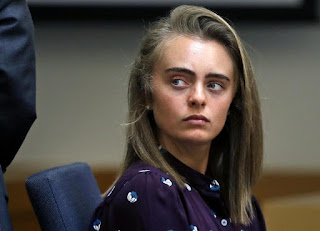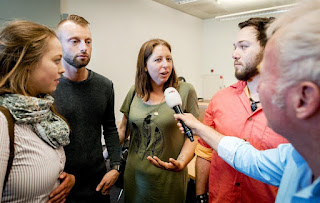Last
week, a Massachusetts judge invoked a 200-year old case as a precedent to hold
a young girl guilty of manslaughter. Both cases raise fascinating legal and
philosophical points.
In
1815, two men convicted of different crimes were in a Massachusetts prison.
Jonathan Jewett, a black man, faced execution for murdering his father. George
Bowen, a career thief, was in the neighbouring cell. They could talk but not
see each other through a grill that separated the two cells.
Jewett
was scheduled to be hanged on 8 November 1815. In those days, executions were
public. Thousands gathered with excitement to watch the terrified face and
later the limp body of the convict. The Sheriff of the town always made it a
point to be present. Like directors are paid fees for attending a company’s
meeting these days, the Sheriff was paid fees for attending each execution.
Bowen
and Jewett often talked through the cell grill. ‘Why let them hang you in
public, why not hang yourself’, Bowen suggested to Jewett. He told Jewett how
one could be resourceful and create a noose from a bed sheet. It should be noted that Bowen was profane,
querulous, hot-tempered and mean-spirited. He hated black people. But he found
joy at the prospect of denying the pleasure of the spectacle to the thousands
gathering to see his fellow-convict die, and denying the fees to the Sheriff.
Bowen continually urged, advised and persuaded Jewett to commit suicide.
Six
hours before his scheduled execution, Jewett indeed took his own life by
hanging himself in his cell.
Suicide
was a grave crime and sin. Jewett was posthumously charged with that crime
(although he would not be tried or sentenced). His neighbour in prison, George
Bowen, was indicted for ‘murder by counselling’. He was considered not an
accessory to murder, but a participant. The judge repeatedly cautioned the jury
that the fact that Jewett was going to die in another few hours must be
ignored. Nobody has a right to kill a person before the time scheduled by the
State.
The
defence argued that committing suicide was solely Jewett’s decision. Bowen was
not physically present when the suicide took place. Words cannot kill.
Teenage
suicide
200
years later, two American teenagers, Conrad Roy and Michelle Carter, met for
the first time in Florida, while on vacation. They became friends. It appears
that they met only twice in their life. Their two-year relationship was almost
exclusively textual. We live in times where love can be digital. Michelle called
herself Conrad’s girlfriend.
Conrad
suffered from depression and inexplicable anxiety. He often considered ending
his own life. In July 2014, Michelle encouraged, urged, and persuaded him to go
ahead. Gassing himself in his car was an option, and she gave him detailed instructions
to do so. Conrad obtained the necessary equipment. On 12 July 2014, he was once
again dared by his girlfriend to show he could keep his word. When Conrad
entered his car and the fumes began choking him, he came out. He was on the phone
with Michelle all the time. ‘Get back into the car, don’t give up’, she
ordered. Conrad re-entered the car with his phone in his hand and died of
Carbon monoxide twenty minutes later. Throughout that time, his girlfriend
heard him moaning and gagging on the phone. Conrad Roy was 18 when he died, and
his digital girlfriend was 17.
Commonwealth
of Massachusetts vs Michelle Carter
The
defence argued Conrad was suicidal and he might have taken his life one day any
way. Michelle was 35 miles away when Conrad killed himself, and they had not
met for over a year. Text messages were mere words, how could one cause death
through words?
Some
legal experts argued the USA has freedom of speech. While Michelle’s conduct
was awful, it can’t override her freedom of speech. She could at best be tried
for cyberbullying, not for manslaughter.
The
prosecution argued Michelle urged Conrad to commit suicide. Though not
personally present, she was on the phone with him, she was in his ears, she was
in his mind. In that sense, she was with him when he died.
The
judge said Michelle’s conduct was reckless and wanton. When Conrad came out of
the car, confused, she asked him to go back in. Instead of calling for help,
alerting Conrad’s family or police, she was on the phone with him until he
died. She could have taken steps to stop him or seek help, it was her duty. Not
doing so amounted to criminal conduct. Michelle Carter was held guilty of
manslaughter and faces up to 20 years in prison. The exact quantum of
punishment will be announced on 3 August 2017.
Sample
text messages
Here
are some of the sample text messages between the teenagers.
Michelle
to Conrad: Yeah, it will work. If you emit 3200 ppm of
it for five or ten minutes you will die within a half hour. You lose
consciousness with no pain. You just fall asleep and die. You can also just
take a hose and run that from the exhaust pipe to the rear window in your car
and seal it with ducttape and shirts, so it can’t escape. You will die within, like,
20 or 30 minutes all pain free.
Michelle
to Conrad: Don’t do it in the driveway. You will be
easily found... Find a spot. Just park your car and sit there and it will take,
like 20 minutes. It’s not a big deal.
Conrad
to Michelle: Okay. I’m gonna do it today.
Michelle
to Conrad: You promise?
Conrad
to Michelle: I promise, babe. I have to now.
Michelle
to Conrad: Like right now?
Conrad
to Michelle: Where do I go?
Michelle
to Conrad: And you can’t break a promise. And just go
in a quietparking lot or something.
Conrad to Michelle: 7/12/2014|3:40:35 p.m.: I’m determined
Michelle to Conrad:
7/12/2014 | 3:41:33 p.m.: I'm happy
to hear that
Michelle to Conrad:
7/12/2014 | 3:47:18 p.m.: When you get back from the beach, you
gotta … do it….
Conrad to Michelle:
7/12/2014 | 4:26:55 p.m.: no more thinking
Michelle to Conrad:
7/12/2014 | 4:26:55 p.m.: Yes, no more thinking you need to
just do it...
Michelle to Conrad: 7/12/2014 | 5:17:23 PM ...Did you delete the text messages?
Motive
What
could be a possible motive for such messages, for a young girl to urge her digital
boyfriend to commit suicide?
It
seems Michelle wanted to gain attention, draw sympathy from her girlfriends.
She had already told them (texted perhaps) about this suicidal boyfriend of
hers. In her mind, they were getting sick of the suicide threats that never
materialised; they didn’t trust her any more. Michelle needed to prove to them
she meant what she had said. On Conrad’s death, she could become the ‘grieving
girlfriend’.
This
role of the grieving girlfriend is apparently inspired by American serials. A
Netflix series “13 reasons why” is about a 17 year old girl who commits suicide
and leaves behind a series of audiotapes describing her reasons. It’s been
criticised as glamourising teenage suicide. About 5000 American teenagers
commit suicide every year.
In
another TV show “Glee”, its young actor died of drug overdose in real life.
This death was included in the script after he died. Rachel, the fictional
young girl in Glee, is the grieving girlfriend. Perhaps not as a
coincidence, many of the text messages by Michelle Carter were found to be
word-for-word with the lines uttered by Rachel in Glee.
Freedom
of speech
Michelle,
while urging Conrad to kill himself, hadn’t forgotten to ask him to delete all
messages before dying. She had deleted the messages as well. However, the
police recovered all deleted messages between them, since technology now allows
such retrieval.
If
you read detective novels, you are familiar with “Miranda rights” where the
police are obliged to warn a possible culprit that he has a right to remain
silent. An accused can’t be forced to say anything that may incriminate him.
The fifth amendment of the USA constitution extends that privilege to witnesses
as well.
If
the communication between Conrad and Michelle was personal or telephonic (but
not recorded), nothing would have happened to Michelle. We have heard the
expression ‘his word against mine’ used in eyewitness testimony. In the 1815
case, the Jury pronounced George Bowen “not guilty”. One reason was that his
alleged conversations with Jewett couldn’t be verified.
Michelle’s
conversations with the dead boy, unfortunately for her, were in the form of a
text message. She dug her own grave by recording everything she was saying. One
peculiarity of this trial was that the prosecutor and witnesses were reading
the text messages from a computer screen rather than recalling from memory.
This
case also brings the real world and virtual world closer. Crimes can be committed
without physical actions or presence. Orders over the phone or text messages
are as good as the person’s presence.
Euthanasia
One
concern raised by legal experts is that this case sets a precedent that can
attract “manslaughter” charges for someone offering euthanasia or mercy
killing.
First
of all, Euthanasia is not legal anywhere in the world. A doctor or a close
relative mercy-killing a patient ailing from a painful, terminal illness can be
prosecuted for manslaughter.
In
certain countries such as Benelux or Switzerland, a Physician Assisted Suicide
(PAS) is legal. The regulations are strict; there are enough controls to make
sure the process is not abused. The doctor explains to the patient how to
administer the medicine. It is the patient himself who must inject or consume
the medicine.
Except
these countries, assisted suicide is illegal and can qualify as manslaughter.
In the case of Conrad Roy, he was a physically healthy young teenager with an
anxiety disorder. It’s possible he could have overcome his depression and led a
long life.
Your
verdict
Apparently
Massachusetts doesn’t have a law against encouraging suicide. Many other US
states have such a law. That’s the reason some people argue Michelle Carter
can’t be held guilty.
If
you or I were in the judge’s chair, we would find adjudicating this case
equally difficult. Carter’s defence waived the right for a jury trial because, I
think, they feared jury are more emotion-prone.
I
believe the judge was absolutely right in holding her guilty. Even if you
assume a teenage girl may not understand the implications of her actions, you
have a dead boy as a consequence. I personally believe in the spirit more than
the letter of the law. In this case, justice requires overriding
technicalities. Any fair minded person simply reading the anthology of her text
messages (included in the footnote) will declare Michelle Carter guilty.
The
sentence would be announced on 3 August. Of course, she would not be given 20
years, the possible maximum, I don’t think. The fact that she is out on bail
until the sentence suggests the court will be lenient in view of her age.
Sending a young girl to jail would destroy her life, it would make her prone to
committing further crimes. My prediction is that she will be asked to spend two
years or so in some form of community service for rehabilitation.
And
one big lesson for everybody else: Be careful when sending text messages. They
document your communication that can be recovered even when you delete it. Your
reckless text messages can incriminate you and send you to jail as well.
Ravi
Web-o-graphy
(1)
http://www.wsc.mass.edu/mhj/pdfs/murder%20by%20counseling.pdf
: the 1816 ‘murder by counselling’ case of George Bowen. A detailed narrative.
(2)
http://www.cbsnews.com/news/death-by-text-the-case-against-michelle-carter/
: Death by text: a detailed video report.
(3)
https://www.scribd.com/doc/276206526/Michelle-Carter-Texts
: All text messages between the Conrad Roy and Michelle Carter.
R.










